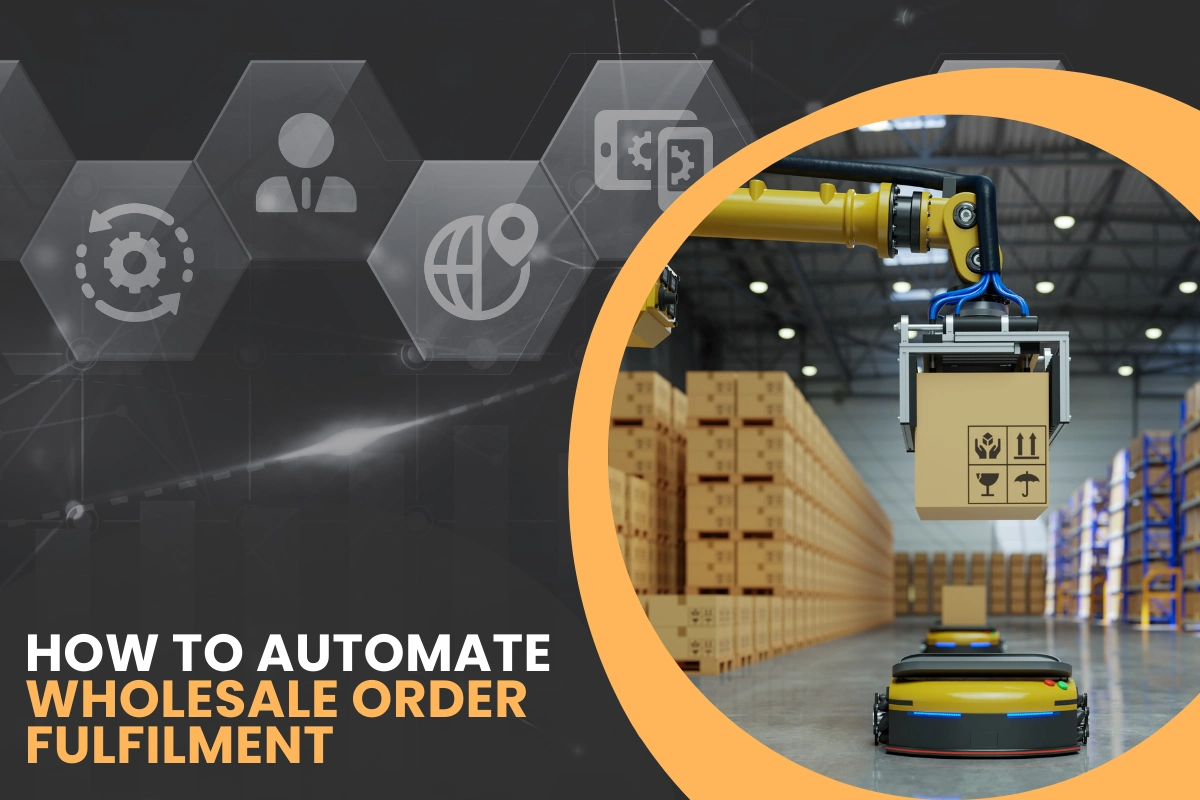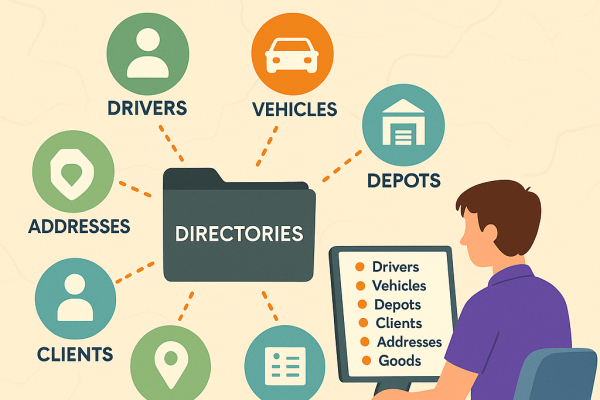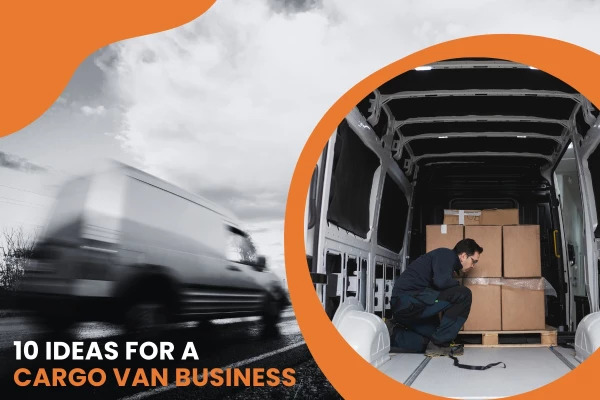- Industries
- Best Practices
How to Automate Wholesale Order Fulfilment

by
Jennifer Collins
May 06, 2024
No matter the size of your wholesale business, managing inventory levels and selling, packing, and dispatching stock to customers can present a few challenges along the way.
The rapid developments in the e-commerce space today have put suppliers, wholesalers, and retailers under tremendous pressure to deliver the goods, and customers have become more demanding in their expectations.
Jump to the most relevant part:
Automation of order fulfillment procedures has been shown to improve visibility and control, reduce costs, provide better customer service, and increase revenue.
According to Gitnux, 66 percent of organizations are considering or are automating their operations. This means that 66 percent of organizations will likely become more competitive shortly—a statistic that should not be taken lightly, as it could impact your business.
What is wholesale order management?
Wholesale order management refers to the process of selling inventory to other businesses (B2B). It encompasses sales orders, inventory control, logistics, and invoicing.

Selling stock requires visibility of stock levels and functionality, such as backorders in case of stock depletion, access to customer details, and delivery addresses.
Wholesalers play an essential role in the retail process, as they commit to keeping enough stock so that retailers can fill their shelves. Because wholesalers deal with large inventory volumes, they can enter special deals with retailers, reducing prices based on volumes sold. This often means managing complicated pricing structures and discount tables. Integrating a comprehensive payment platform helps navigate these intricacies, ensuring that complex billing remains accurate and efficient.
Inventory management is the process of managing stock levels, making sure you don’t run out of stock, and, at the same time, ensuring that you don’t have too much, as it impacts costs and affects your cash flow. Keeping too much stock in your warehouse increases the risk of products becoming redundant, and it takes up space. If you factor in overheads such as power, staff salaries, and equipment, the costs of keeping excess stock increase significantly.
Keeping inventory levels at a minimum may decrease costs, but keep in mind that if you continuously run out of stock, your customers will go elsewhere.
Thus, successful inventory management means accurate sales forecasting based on historical data and current market trends. It means knowing your products and building in safety levels to reduce the risk of running out and placing a ceiling on your reorder quantities so you don’t overstock.
Order management also involves packing and dispatching stock to customers. A smooth delivery process requires accurate customer address details, the necessary documentation so drivers know where to deliver the goods, and obtaining a customer’s signature as proof of receipt.
How do you automate a wholesale business?
Wholesale order fulfillment is a dynamic process that requires a seamless flow from beginning to end. This means having:
- A sound sales order entry system that can access customer address details and payment information, with real-time access to stock availability, pricing, and delivery times.
- Inventory levels that are accurate and visible to sales staff and customers, with backorders and automated procurements when stock runs out.
- A delivery process that encompasses efficient route planning, driver and cargo safety, reliable delivery vehicles, and a reliable POD process.
- Customer service that includes effective communications and enables customers to track their orders.
When automating order processes in wholesale, the above is essential, as it offers:
- improved visibility and efficiency in the sales order process.
- Less risk in terms of stock keeping, lowering costs and improving financial outcomes.
Using robotics and digital technology in the warehouse reduces picking and stock binning errors and improves product pick speed.

Delivery route planning and vehicle tracking improve the customer experience, save you money and time, and reduce fuel and vehicle maintenance costs. By automating the last mile of your delivery process, you eliminate all the things that can go wrong, speed up the delivery process, improve the safety of your drivers and your cargo, and identify potential problems with the vehicle.
Automation inevitably increases your potential for scalability regarding data storage and the leverage for effective analysis. The further back you can go when forecasting future sales, the more accurate your forecasting is likely to be.
Automation helps you track customer discount tables, inventory safety levels, maximum and minimum order quantities, and pricing structures.
Automation enables the use of inventory strategies such as FIFO and LIFO.
How to automate a wholesale business - an action plan
To begin with, a thorough analysis of your current processes is essential.
Assessing your needs
A structured approach is needed here to ensure you don’t leave anything out.
- List the functions that are business-critical and that you cannot do without.
- List the items that are less critical but are still important to have.
- List your current challenges with suggested improvements.
Brainstorm these lists with management and key personnel from the various areas of the business.
It helps at this stage to know what technology is out there.
Choosing the right technology
When evaluating system options, the vast array of companies that offer business solutions can be quite overwhelming.
You may already have a standalone system that manages part of the order fulfillment process. Once you have done the needs analysis, the next step is to look around at the latest technology on the market and determine what falls within your price bracket.
Your basic needs for a full wholesale order fulfillment suite are sales orders, inventory tracking, and logistics functionality. We discuss the different software options in the next section.
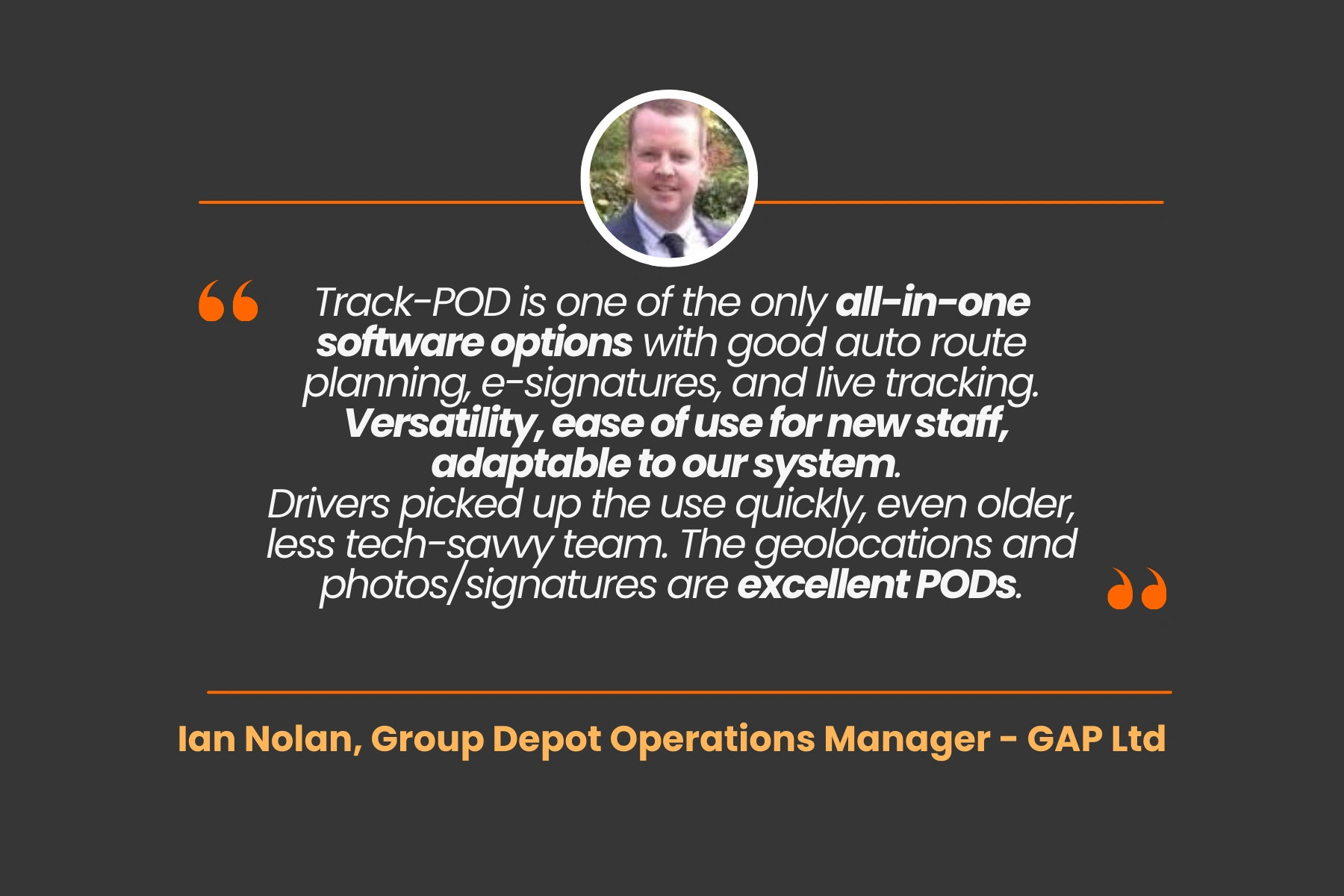
Talk to your contacts in similar businesses to see what they are using.
If you have the budget, employ a consultant to help you analyze your business and suggest solutions. Companies specializing in system analysis and implementation have a good knowledge of the various systems, their strengths and weaknesses, and what would suit your business. This may be costly, but it’s far less expensive than making the wrong decision regarding expensive software and hardware.
Once you have done the research and have a shortlist, see whether you can contact companies using the software options you are considering.
Some software suppliers will give you contact details for other companies using their systems or accompany you on a visit to a live site. This is a good way to get first-hand information and evaluate live systems.
Integration with your other systems
There are a few options to consider when evaluating new software for your wholesale fulfillment process.
Enterprise Resource Planning (ERP)
A fully integrated ERP system manages sales, purchase orders, stock levels, and all financial transactions, debtors, and creditors.
Order management system (OMS)
An OMS system gives you visibility across the supply chain, from purchase orders to stock management, sales orders, and stock issues and deliveries. An order management system will transfer transactional and financial data to the ERP system, updating customer and supplier records, inventory financial costing and sales information, and sales data. Without an OMS, the ERP system will handle sales and purchasing functions.
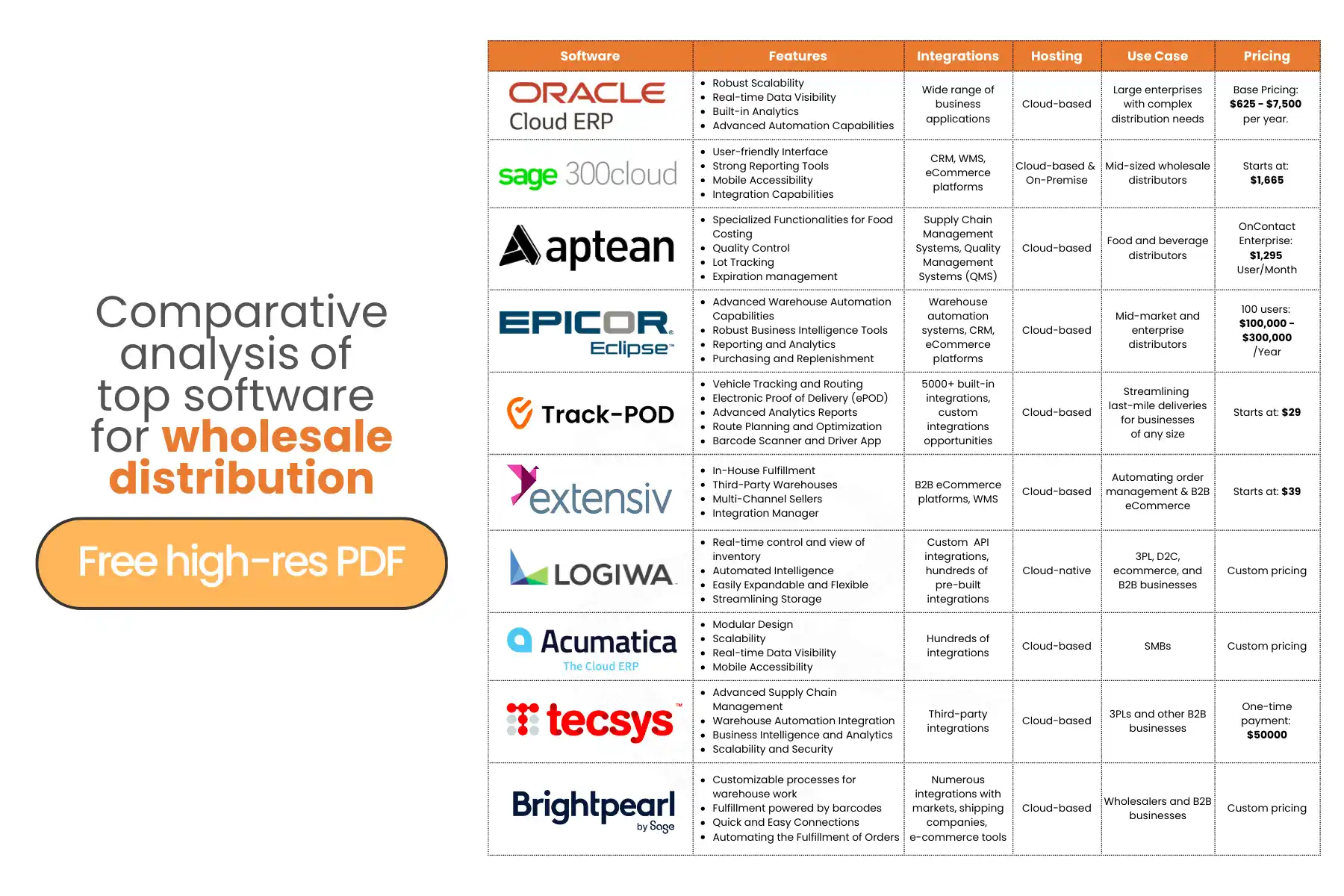
Warehouse management system (WMS)
WMS is a standalone system that integrates with the ERP or OMS systems. It keeps track of stock locations and handles the delivery side of the business. It is not essential to have a WMS system if you have a robust inventory system that handles multiple types of warehouse transactions.
Customer relationship management (CRM)
In today’s competitive environment, it pays to have a SaaS CRM software that contains information relating to sales, returns, marketing information, and strategies. It empowers marketing and sales personnel to record customer preferences as part of their quest to maintain good customer relationships. Sales data is transferred to the CRM system, along with information about products the customer has bought, so that this can be used for future analytical exercises.
In many cases, teams also rely on AI sales enablement features within their existing tools to help interpret customer data more accurately and support day-to-day decision-making.
Whatever your choice in systems, having an efficient delivery strategy is key to customer satisfaction and can save time and money by avoiding unnecessary trips and detours.
Many things can go wrong in this last step of the process: missing stock items, incorrect products, inclement weather, traffic issues, and broken-down delivery vehicles. Ideally, you should have structured delivery procedures, including an automated route planner and vehicle tracking devices that provide real-time feedback to logistics and dispatch staff.
Package information should be transmitted to the delivery management system, where routes are planned and packages loaded onto delivery vehicles. From there, the package goes to the customer, who confirms the receipt. In an integrated system, the proof of delivery updates the ERP or OMS systems immediately, updating customer records, completing the sales order, and producing an invoice for payment.
The Internet of Things (IoT) has enabled seamless integration with other systems and digital devices, allowing data transfer to a centralized database where you can run reports and analyze statistical data for more accurate management decisions.
In addition to sales and inventory information, the delivery software you choose should plan the most efficient delivery routes based on the shortest, most feasible travel distances, considering road conditions and special delivery instructions, if any, that are present.
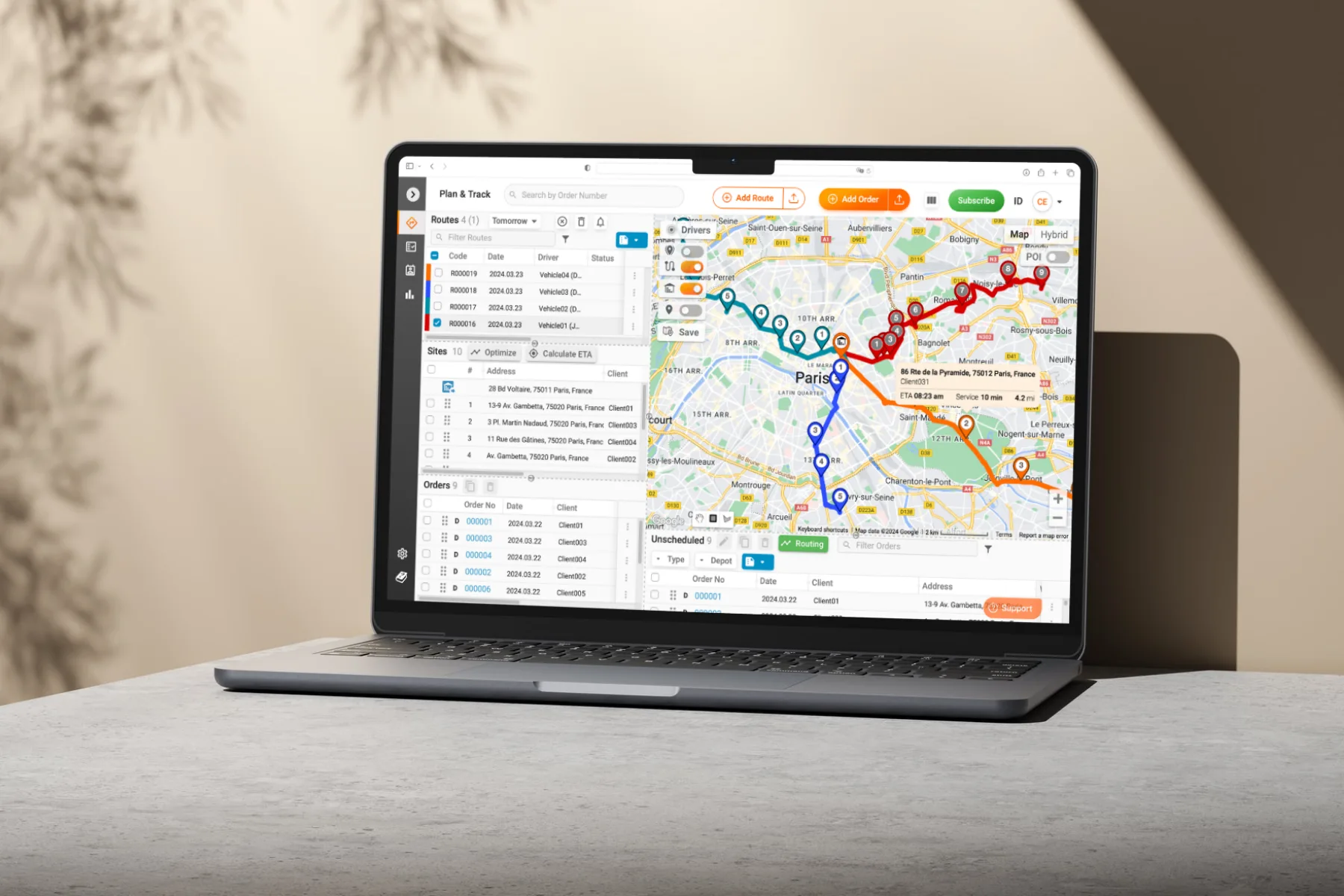
Route planning uses satellite tracking data and the customer addresses captured on the sales order. By leveraging this information, you optimize your routes, saving fuel costs, time, and vehicle wear and tear. And you have happy customers who have been able to track their parcels since they left the warehouse.
Automating order processes
There are many areas in the process of selling and dispatching orders where even a slight tweak in updated technology can save time and frustration.
Sales orders
Can the ordering process be automated?
Yes, most certainly. With online platforms today, you can give your bigger customers access to their own portal on your system. There are limitations to what they can do on your system, but you can allow them to view the stock they are interested in and create their own sales orders.
Inventory levels are updated immediately, and if there is no stock, that product can be automatically back ordered and simultaneously appear on a procurement list or reported elsewhere in the organization for action by the procurement team.
Customers can check on the progress of their backorders and the status of their deliveries.
Inventory
Stock procurement can be done automatically by flagging products with different criteria, such as fast-moving or high-demand products. The system will put forward a list of suggested orders per supplier with an option for approval by a manager before placing the order.
Automation in warehousing can be anything from simply scanning barcodes and allocating stock to individual bin locations, or it can be fully automated using system-driven forklift equipment, drones, or robots.
Barcode readers and scanners make life easier for warehouse personnel and reduce errors such as incorrect binning and lost items.
Automated route planning calculates how many parcels can be loaded onto trucks based on size, weight, and truck capacity, ensuring that all orders for a specific customer are loaded onto the same truck and not split across different vehicles.
Many commercial vehicles today come with built-in tracking devices, as it is a legal requirement in many countries. Vehicle tracking provides many advantages, from vehicle diagnostics to monitoring driver hours and behavior on the roads, breakdowns, and hijackings in high-risk areas.
Further automation of delivery processes includes using drones in outlying areas that are difficult to reach and mobile apps that take photos as proof of delivery.
No-contact deliveries became popular in early 2020 due to the pandemic, and demand for this type of delivery is increasing.
Communication between dispatch management, drivers, and customers is another area where automation is key, mainly when things go wrong. Dispatch managers can monitor routes on a dashboard in their office and communicate with drivers to reroute vehicles if they identify potential problems on the route.

Drivers can fetch customer returns and record the details employing apps on their mobile devices, with instant updates into the various systems, such as order processing, inventory, and financials.
Customers can track the status of their deliveries and have accurate ETAs around which they can plan their business commitments.
Challenges and solutions
New system implementations usually come with their quota of teething problems, but fortunately, if you are prepared for them, they should be manageable.
Integration between systems may present technical challenges; however, most system providers will have experience in this field if the system is approved as compatible. The problems occur with customizations that may have been done to an existing system, such as the ERP software, and the changes could be long-forgotten.
Before buying a new system, it is imperative to check what other query or programming languages the new system supports and what technology it uses as a communication medium.
Before integrating the two systems, a thorough check needs to be done regarding data structures and tables, possible software customizations, and how the implementation will affect those areas.
Staff training is another vital factor in the successful implementation of a system. Staff should be able to see the new system's value so that you get their buy-in. If this stage is not handled correctly, you will be dealing with a demotivated and frustrated group of people who are a potential risk regarding accuracy and low productivity. Give them some responsibility by getting them involved in user acceptance testing. This serves a dual purpose—to test the software and to keep your staff motivated.
Conclusion
In light of the above, it is clear that automation in various areas of your business is an essential part of staying competitive and keeping your customers satisfied. Your staff is likely to be more motivated as they are freed up to focus on more productive work, and the effect of this will be an increase in productivity.
Faster, more efficient processes will mean savings in costs and time, with both your business and your customers reaping the benefits of increased productivity. Your company should be able to manage more sales without increasing your staff complement, and you will have tighter control over costs and operational efficiency.
Today’s business environment is racing, and companies simply cannot afford to lose momentum. Embrace change and be surprised at what you can achieve.
About The Author
Jennifer Collins
A seasoned content writer with a passion for unraveling the intricate world of logistics through words.

